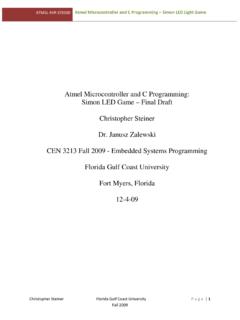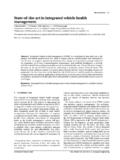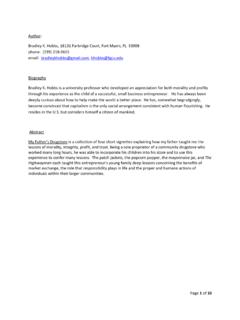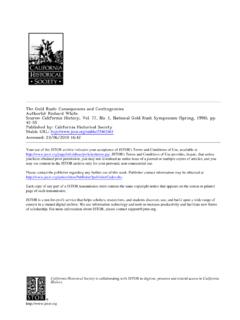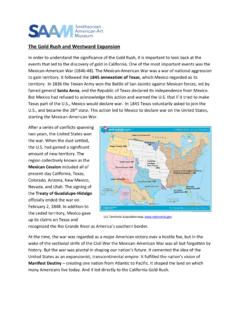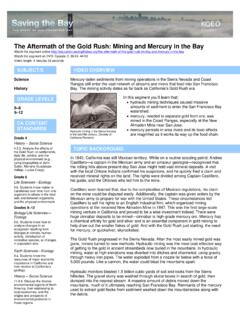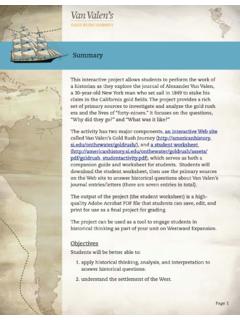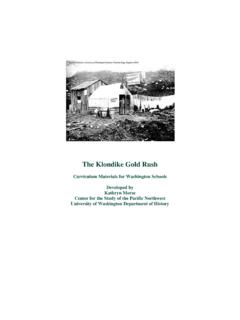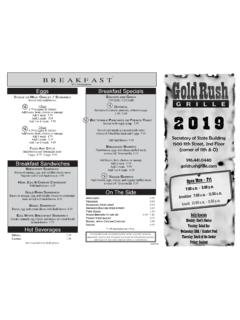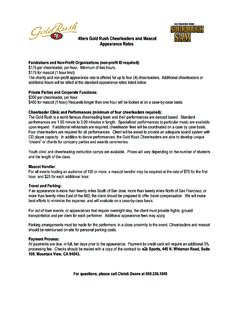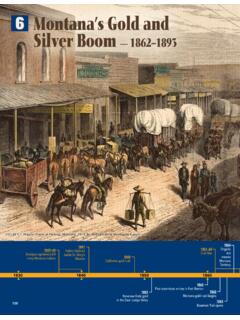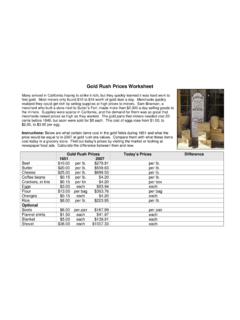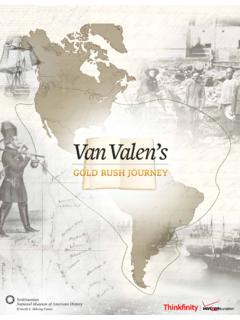Transcription of The California Gold Rush: A Study of Emerging Property …
1 EXPLORATIONS IN ECONOMIC HISTORY 14, 197-226 (1977) The California gold rush : A Study of Emerging Property Rights* JOHN UMBECK Department of Economics, Purdue University INTRODUCTION For over 2000 years political philosophers, historians, anthropologists, and sociologists have sought an explanation for the emergence of private Property rights (I). More recently, economists have joined in the search (2). This paper was written to present some of my own ideas on the subject, ideas which hopefully the reader will regard as an advance in our under- standing of a complex subject. The concept of Property rights is not an easy one to define unambigu- ously. The key to understanding it is probably to be found in the notion of exclusivity. For an individual or group of individuals to claim a right to some Property they must first be able to exclude all other potential claimants.
2 With the competition excluded, the individual can then decide how the Property will be used and who shall get the income derived from it. Of less importance, but generally included in the concept of Property right, is the notion of transferability. This means that the owner of the exclusive rights can transfer them to someone else in exchange for the exclusive rights to other Property . Of course, the right to exclude must precede the right to transfer, because without the former there would be nothing to transfer. Still, what does it mean to have a right? The right to use a Property , to derive income from it, and to exchange it all refer to future events, and future events are uncertain. Therefore, to say that an individual has a right is to say that he has some expectation that his decision regarding the use of some Property is in fact how it will actually be used.
3 In order to render this definition operational it is necessary to identify some observable variable to serve as a proxy for expectations. The one I have chosen is an explicit contract (3). In this contract, two or * I would like to give special thanks to Steven Cheung and Yoram Barzel. Without their help, this work would never have begun and to the people at the Bancroft Library, whose assistance made my research a relatively pleasant task. I am also indebted to the National Science Foundation, the Foundation for Research in Economics and Education at UCLA, and the Krannert Graduate School at Purdue University for their financial assistance. Copyright 0 1977 by Academic Press, Inc. All rights of reproduction in any form reserved. 197 ISSN 00144983 198 JOHN UMBECK more individuals will agree upon who has the right to do what with specific resources.
4 In other words, the contract will assign to each individual the rights to some of the scarce resources in the economy. Of course these rights will be limited so as to constrain the owner s actions in certain ways. For example, the rights to the use of a gun will not include the right to shoot another person and take over his Property (4). Finally, the contract must provide some mechanism for enforcing the agreed-upon rights. With- out this, the contract would be of little value. In particular, the question being addressed here is the following: If a group of individuals is placed in a world of scarce resources, with no government to assign ownership rights and no laws to restrict individual behavior, what will they do? Will they get together and agree on a set of rights to be rationed out among the group or will they choose to forego any agreements and instead resort to the use of personal violence to maintain exclusivity over resources they claim for themselves (5)?
5 To answer this question, I will develop a theory of Property rights through contract. The theory, presented in the next section, will allow the deriva- tion of potentially refutable implications. In the last section, these implica- tions are tested against the backdrop of a most unique historical event, the California gold rush of 1848 and 1849. Theory It has long been thought that the income from a scarce resource would tend to dissipate if no exclusive rights to that resource existed (6). These casual suppositions were first formalized into a theory by Cheung in his article The Structure of a Contract and the Theory of a Nonexclusive Resource. In anticipation of the discussion of the California gold rush , I shall briefly restate Cheung s hypothesis in terms of gold -producing land.
6 Figure 1 will help visualize the argument. In this graph, the horizontal axis measures the quantity of labor being devoted to mining effort, while holding constant the total amount of gold -bearing land. The vertical axis measures the marginal and average products of labor in terms of gold output. MP is the marginal product curve and AP is the average product curve. Both are assumed to be linear to simplify the exposition. All labor inputs are homogeneous and face an alternative wage equal to OF. If the mining land was privately owned, the proprieter would use OA units of labor effort to maximize the rental stream, FEC. Labor would be employed in such a way that the MP is equal to the foregone alternative wage rate. On the other hand, if no individual has the right to exclude others from the gold land, the positive rent will attract more labor.
7 With OA units of labor effort already on the land, the additional worker will perceive his own MP to be equal to MP . He will therefore apply extra labor effort until his MP is equal to his wage, or AK units. Because THE California gold rush 199 gold , E I/ ) 0 A K B Labor Effort gold Land FIGURE 1. of this extra labor, the first miner will perceive a decline in his MP, causing him to reduce his labor effort. This, in turn, will lead to an increase in the perceived MP of the second miner and he adjusts his labor effort accordingly. This process ceases when the two miners are supplying the same quantity of labor. However, if there still remains some rent from the gold land, more miners will be attracted and the process will begin all over. Positive rents will exist as long as the average product of labor is greater than the wage rate.
8 As more and more labor effort is added to the limited land, the average product will decline. Under the assumption that no individual can exclude anyone else, the new equilibrium will be at OB labor effort. Here, the AP of labor is equal to the wage, rents are zero, and no more labor will be attracted to the gold land (7). There are three important conclusions which can be derived from this theory. First, in the absence of any exclusive rights, the income attribut- able to the nonexclusive resource will tend to dissipate. In fact, given the assumptions above, all of the rent from the gold land, FEC, will be com- peted away. The total product of OB labor will be equal to OFDB, which is equal to the foregone wages of labor. No residual remains from the nonexclusive gold land.
9 Second, because of this dissipation, there are po- tential gains from excluding some of the labor and establishing Property rights to the land. If AB labor can be kept off the land, the total social product will increase by FEC as the excluded labor takes their next-best alternative at the going wage. Third, the potential gains from establishing Property rights will increase with the productivity of the land. If, for example, the land is discovered to contain more gold than previously supposed, the MP and AP curves will shift upward. More labor would be attracted until the new AP equaled the wage. The total income dissipated would now be greater than before and the potential gains from excluding some labor would be larger. While Cheung s model was the first formal explanation of the dissipation of nonexclusive income and the gains from establishing Property rights, 200 JOHNUMBECK these concepts had not gone unnoticed in the economic literature.
10 For example, Demsetz, in his article Toward a Theory of Property Rights, suggests that the opening up of the European fur trade raised the value of animal hides among the American Indians of the Labrador Peninsula. As a result, more labor effort was allocated to the nonexclusive hunting lands which, in turn, resulted in dissipation of income (8). Furthermore, Demsetz argues that it was because of this increase in the potential gain from excluding some hunters that the Indians established Property rights to land. This conclusion unfortunately does not follow. It ignores the costs of forming exclusive rights. Because I am examining the emergence of Property rights through ex- plicit agreements, it is possible to specify the nature of the associated costs in terms of a contract.
